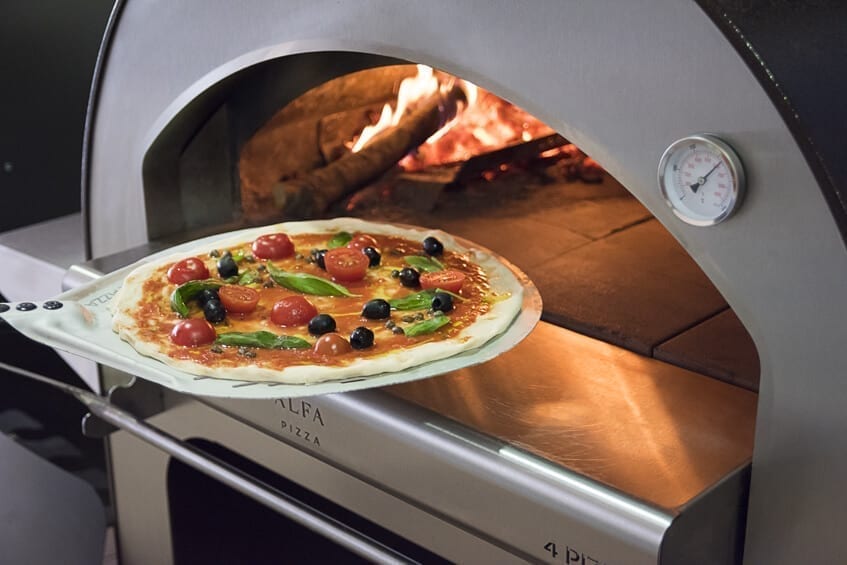Sooner or later all pizza makers wonder whether there is a relationship between the pizza dough that they make and the oven in which they will bake it. Of course there is. Pizza making is a process that involves lots of variables such as:
- Quality of raw materials.
- Pizza maker’s skills and experience.
- Time, method and preparation of pizza dough.
- Oven’s features.
In this article, we will focus on how to make a great pizza dough considering the type of oven and give you some useful tips for tweaking it in such a way as to bang out mouth-watering pizzas.
Pizza doughs: types and characteristics
Making pizza dough is simple and complex at the same time. It’s simple because it’s based on the ingredients of bread; pizza was a poor man’s staple that was chucked into the oven to check the temperature before baking the family loaf. It’s complex because the whole process involves different chemical and physical reactions occurring in various phases.
Ingredients
There are usually two ways to combine the ingredients: dissolve the yeast into the water and then gradually add flour, sugar, olive oil and salt at the end or add the yeast to the flour and then add water, olive oil and keeping salt for last. Hydration refers to the volume of water relative to the amount of flour in the dough; a good hydration results in a more airy and digestible pizza even though the dough will be more difficult to knead.
Kneading
Kneading is probably the most daunting part of the process. By working the dough, proteins start connecting to each other to form a gluten network of fine strands that will trap gases coming from yeast’s fermentative action. Work the dough energetically for about 10 minutes until it is smooth and elastic. Many pizza chefs suggest taking one or two breaks during stretching to allow dough to relax.
First rise
During this stage, fermentation occurs, dough swells and doubles in size. Major factors here are time and temperature: the warmer the dough, the faster the yeast produces carbon dioxide.
Dividing the dough
Dough is shaped into balls of about 200/300 g (or more for pan pizza) for a final rise before baking. Work the dough gently to obtain a light and digestible pizza.
Stretching the dough
A well-proofed pizza dough can be stretched so thin without tearing it. If the gluten is too developed, the dough doesn’t stretch easily if, on the contrary, the gluten is underdeveloped, it tends to tear.

The pizza recipe must more or less follow these steps even though there are at least as many pizza recipes as there are restaurants. Neapolitan pizza making has recently made the UNESCO’s list of Intangible Cultural Heritage of Humanity and has its own rules but plenty of regional variations exist such as Genoese focaccia, Apulian puccia or Roman pinsa.
Pizza’s main ingredient is wheat flour and depending on the protein content of the grain it may be weak or strong. Flours with a high W (flour strength index) have better resistance and need more time to mature.
You can use wheat flour for making pizza dough, but you can also experiment on you own to find the right flour mix that best suits your taste. In our blog we dealt with the factors that affected dough rising and maturation in order to produce a soft and light pizza. Now it’s time to focus on the type of oven.
How to make pizza dough that suits to your oven
Making great pizza dough is key for cooking a gorgeous pizza afterwards, whichever the oven. Your pizza making savvy and experience coupled with the perfect knowledge of your oven’s features will allow you to find out the recipe to churn out pizzas like a pro. In our blog we have often talked up the different types of ovens and their characteristics. Let’s do a quick recap:
- The wood-fired oven is the real deal. It can reach the highest temperature and can impart food that unique extra oomph of smoked taste. There’s no better way to cook pizza even though it’s expensive and hard to manage.
- The electric oven is cheap and convenient, but it doesn’t reach very high temperatures and for this reason is not good for baking pizza.
- The gas-fired oven is a halfway house between the handy electric oven and the high-temp wood-fired oven.
Within these three broad categories there is a wide array of models that stand out for their size, performance, style and price.
How to adapt pizza dough to your oven
The key factors for the oven to get the most of your pizza dough are related to the temperature and humidity of the cooking chamber, to the way the heat is transferred during baking and, of course, to the observance of maintenance and cleaning instructions all over the product lifespan. A good oven provides as constant a temperature as possible in all cooking areas.
In a wood-burning oven, the heat absorbed from the fire inside the oven is radiated back down from the dome and actually cooks a lightly browned pizza, crispy on the outside but chewy in the middle. A pizza baked in an electric or a gas-fired oven will take longer and will therefore need more hydration to prevent it from drying out during cooking.
After some cooking, you will feel that your pizza dough is the right one and that the oven is ready. But, most of all, don’t be afraid to experiment with pizza dough and to learn the features of your oven by trial and error and you will certainly find the way to make pizzas like a pro.



